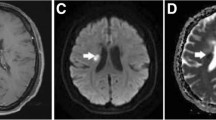Abstract
Objectives
To assess the usefulness of the visual assessment and to determine diagnostic value of the lesion-to-cerebral cortex signal ratio (LCSR) measurement in the differentiation of demyelinating plaques and non-specific T2 hyperintensities on double inversion recovery (DIR) sequence.
Material and methods
DIR and fluid-attenuated inversion recovery (FLAIR) sequences of 25 clinically diagnosed multiple sclerosis (MS) patients and 25 non-MS patients with non-specific T2-hyperintense lesions were evaluated visually and LCSRs were measured by two observers independently.
Results
On DIR sequence, the calculated mean LCSR ± SD for demyelinating plaques and non-specific T2-hyperintense lesions were 1.60 ± 0.26 and 0.75 ± 0.19 for observer1, and 1.61 ± 0.27 and 0.74 ± 0.19 for observer2. LCSRs of demyelinating plaques were significantly higher than other non-specific T2-hyperintense lesions on DIR sequence. By using the visual assessment demyelinating plaques were differentiated from non-specific T2-hyperintensities with 92.8 % sensitivity, 97.5 % specificity and 95.1 % accuracy for observer1 and 92.8 % sensitivity, 95 % specificity and 93.9 % accuracy for observer2.
Conclusion
Visual assessment and LCSR measurement on DIR sequence seems to be useful for differentiating demyelinating MS plaques from supratentorial non-specific T2 hyperintensities. This feature can be used for diagnosis of MS particularly in patients with only supratentorial T2-hyperintense lesions who are categorized as radiologically possible MS.
Key Points
• Demyelinating plaques and non-specific T2-hyperintensities have different SI on DIR images.
• These differences can be assessed by LCSR measurement or visual assessment.
• There is an excellent inter-observer agreement for both methods.
• This feature can be used in radiologically possible MS cases.





Similar content being viewed by others
Abbreviations
- LCSR:
-
Lesion to cerebral cortex signal ratio
- DIR:
-
Double inversion recovery
- FLAIR:
-
Fluid-attenuated inversion recovery
- GE:
-
Gradient echo
- MRI:
-
Magnetic resonance imaging
- MS:
-
Multiple sclerosis
- SE:
-
Spin-echo
- UBO:
-
Unidentified bright objects
- VEP:
-
Visual evoked potential
- SEP:
-
Somatosensory evoked potentials
- CSF:
-
Cerebrospinal fluid
- ROC:
-
Receiver operating characteristic
- ICC:
-
Intraclass correlation coefficient
- PPV:
-
Positive Predictive value
- NPV:
-
Negative predictive value
- SI:
-
Signal intensity
- TR:
-
Repetition time
- TE:
-
Echo time
- EDSS:
-
Expanded disability status scale
- RRMS:
-
Relapsing-remitting MS
References
Lebrun C, Cohen M, Chaussenot A et al (2014) A prospective study of patients with brain MRI showing incidental T2 hyperintensities addressed as multiple sclerosis: a lot of work to do before treating. Neurol Ther 3:123–132
Debette S, Markus HS (2010) The clinical importance of white matter hyperintensities on brain magnetic resonance imaging: systematic review and meta-analysis. BMJ 341:c3666
Yoshita M, Fletcher E, DeCarli C (2005) Current concepts of analysis of cerebral white matter hyperintensities on magnetic resonance imaging. Top Magn Reson Imaging 16:399–407
Polman CH, Reingold SC, Banwell B et al (2011) Diagnostic criteria for multiple sclerosis: 2010 revisions to the McDonald criteria. Ann Neurol 69:292–302
Selchen D, Bhan V, Blevins G et al (2012) MS, MRI, and the 2010 McDonald criteria: a Canadian expert commentary. Neurology 79:S1–S15
Bedell BJ, Narayana PA (1998) Implementation and evaluation of a new pulse sequence for rapid acquisition of double inversion recovery images for simultaneous suppression of white matter and CSF. J Magn Reson Imaging 8:544–547
Geurts JJ, Pouwels PJ, Uitdehaag BM et al (2005) Intracortical lesions in multiple sclerosis: improved detection with 3D double inversion-recovery MR imaging. Radiology 236:254–260
Turetschek K, Wunderbaldinger P, Bankier AA et al (1998) Double inversion recovery imaging of the brain: initial experience and comparison with fluid attenuated inversion recovery imaging. Magn Reson Imaging 16:127–135
Wattjes MP, Lutterbey GG, Gieseke J et al (2007) Double inversion recovery brain imaging at 3T: diagnostic value in the detection of multiple sclerosis lesions. AJNR Am J Neuroradiol 28:54–59
Nelson F, Poonawalla AH, Hou P et al (2007) Improved identification of intracortical lesions in multiple sclerosis with phase-sensitive inversion recovery in combination with fast double inversion recovery MR imaging. AJNR Am J Neuroradiol 28:1645–1649
Sethi V, Muhlert N, Ron M et al (2013) MS cortical lesions on DIR: not quite what they seem? PLoS One 8:e78879
Wardlaw JM, Smith C, Dichgans M (2013) Mechanisms of sporadic cerebral small vessel disease: insights from neuroimaging. Lancet Neurol 12:483–497
Frohman EM, Racke MK, Raine CS (2006) Multiple sclerosis--the plaque and its pathogenesis. N Engl J Med 354:942–955
Wu GF, Alvarez E (2011) The immunopathophysiology of multiple sclerosis. Neurol Clin 29:257–278
Greenfield JG, Love S, Louis DN, Ellison D (2008) Greenfield's neuropathology, 8th edn. Hodder Arnold, London
Acknowledgments
The scientific guarantor of this publication is Bilal Battal. The authors of this manuscript declare no relationships with any companies, whose products or services may be related to the subject matter of the article. The authors state that this work has not received any funding. Complex statistical methods were necessary for this paper. The statistical analysis was performed by Prof.Dr.Selim Kilic (Gulhane Military Medical Academy, Department of Epidemiology, Ankara, Turkey). Institutional Review Board approval was obtained. Written informed consent was not required for this study because of its retrospective design.
None of the study subjects or cohorts have been previously reported. Methodology: retrospective, diagnostic, performed at one institution.
Author information
Authors and Affiliations
Corresponding author
Rights and permissions
About this article
Cite this article
Hamcan, S., Battal, B., Akgun, V. et al. The value of qualitative and quantitative assessment of lesion to cerebral cortex signal ratio on double inversion recovery sequence in the differentiation of demyelinating plaques from non-specific T2 hyperintensities. Eur Radiol 27, 763–771 (2017). https://doi.org/10.1007/s00330-016-4379-2
Received:
Revised:
Accepted:
Published:
Issue Date:
DOI: https://doi.org/10.1007/s00330-016-4379-2




